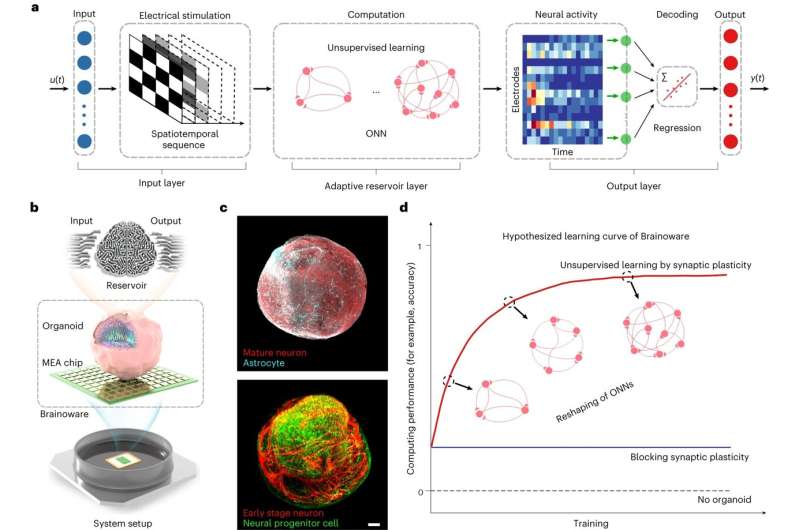
Clusters of lab-raised brain cells connected to a computer are capable of elementary speech recognition and math problems.
Feng Guo, a bioengineer in the Department of Intelligent Systems Engineering at Indiana University, Bloomington, said his study is a major step in demonstrating how brain-inspired computer neural networks can advance artificial intelligence capabilities.
Guo and his team grew bundles of specialized stem cells that developed into neurons, the main component of the brain. A typical brain consists of 86 billion neurons, each neuron connected to as many as 10,000 other neurons.
The ball of neurons, known as an organoid, created in Guo’s lab is less than a nanometer wide. It was connected by an array of electrodes to a circuit board, where machine-learning algorithms decoded responses from the organoid.
The researchers dubbed their creation Brainoware.
After a brief training period, Brainoware was able to distinguish between the voices of eight subjects based on their varying pronunciation of vowels. The system achieved an accuracy rate of 78%.
Brainoware was also able to successfully predict a Henon map, a mathematical construct in the field of chaotic dynamics, with greater accuracy than an artificial network.
“This is a first demonstration of using brain organoids [for computing],” says Guo. “It’s exciting to see the possibilities of organoids for biocomputing in the future.”
A key advantage of biocomputing is its energy efficiency. Currently, artificial neural networks consume several million watts of energy a day. The human brain, on the other hand, requires only about 20 watts to function for a day.
Brainoware is “a bridge between AI and organoids,” Guo said. “Organoids are like ‘mini-brains.'”
“We wanted to ask the question of whether we can leverage the biological neural network within the brain organoid for computing. This is just proof-of-concept to show we can do the job,” Guo said.
A future application for biocomputing systems is studying neurological diseases such as Alzheimer’s. The potential to tap into cellular activity also opens the door to decoding brain wave activity during sleep and possibly recording dreams.
Challenges remain. Among them will be the task of keeping organoids healthy and well-nourished, a 24/7 task.
And there are other concerns as well.
“As the sophistication of these organoid systems increases, it is critical for the community to examine the myriad of neuroethical issues that surround biocomputing systems incorporating human neural tissue,” Guo said.
“It may be decades before general biocomputing systems can be created, but this research is likely to generate foundational insights into the mechanisms of learning, neural development, and the cognitive implications of neurodegenerative diseases.”
“We do have a long way to go,” he added.
The study was published in Nature Electronics.
More information:
Hongwei Cai et al, Brain organoid reservoir computing for artificial intelligence, Nature Electronics (2023). DOI: 10.1038/s41928-023-01069-w
Lena Smirnova et al, Reservoir computing with brain organoids, Nature Electronics (2023). DOI: 10.1038/s41928-023-01096-7
© 2023 Science X Network
Citation:
Brain tissue on a chip achieves voice recognition (2023, December 12)
retrieved 12 December 2023
from https://techxplore.com/news/2023-12-brain-tissue-chip-voice-recognition.html
This document is subject to copyright. Apart from any fair dealing for the purpose of private study or research, no
part may be reproduced without the written permission. The content is provided for information purposes only.
Stay connected with us on social media platform for instant update click here to join our Twitter, & Facebook
We are now on Telegram. Click here to join our channel (@TechiUpdate) and stay updated with the latest Technology headlines.
For all the latest Technology News Click Here
For the latest news and updates, follow us on Google News.
